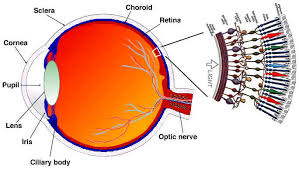Symptoms
Color blindness is a genetic disorder that is associated with the inability of the victims to see some colors in the normal way. The eye senses color in diffrecent objects and the brain translates and perceives the color through nerve cells. The brain understands the color of a given object by retrieving information from pigments in cones. Cones are located in the back of the eye where there is a layer that is sensitive to light. The major symptom of color blindness is the inability to distinguish different colors. Victims of the disorder also have difficulty in distinguishing the brightness of the different colors that they can perceive. Some people with color blindness also fail to distinguish the difference between the various shades of the same color. People with color blindness cannot differentiate between some colors, and their inabilities may be mild or severe. This symptom may appear randomly for people with a mild case of color blindness, but it is a permanent symptom for people with a permanent case of the condition. There are some cases of people that cannot perceive any color in the spectrum. Complete color blindness means that there are no cones developed in the retina; hence, the eye cannot perceive any color. This is a very rare condition that is caused by genetic mutations.
The positions of the different parts of the eye involved in the perception of light and color are highlighted in the figure below. These parts include the optic nerve and the light-sensitive layer. These parts are affected by genetic mutations, and the defects result in different types of color blindness. Color blindness is primarily a hereditary disorder.

Hereditary factors
Color blindness is a mild disability that is caused by mutations in the X chromosome, and it normally affects more males than females. Mothers carry the gene that causes different types of color blindness, and they pass it to their sons. The X chromosome in male children is passed from their mothers; hence, if the mother has the genes that are associated with color blindness, the sons are likely to develop the disorder. There are different types of color blindness that result from hereditary factors. The red-green type of color blindness is caused by a defect in the development of the L-cones. L-cones are responsible for perceiving long wavelengths of light. In some people, the L-cones are missing. Red-green color blindness may also result from the defect or absence of the photopigments of the M-cones. The genetic factors that are responsible for the development of the M-cones and the L-cones are found on the X chromosome. The genes are located next to each other on chromosome. The blue cone monochromacy is another type of color blindness that involves the lack of formations of the M-cones and the L-cones.
Blue-yellow type of color blindness is a defect in the development of the S-cones, which is influenced by genes on chromosome 7. Chromosome 7 is an autosomal type of chromosome; thus, this type of eye blindness affects both males and females. Rod monochromacy is another type of color blindness that is associated with a complete inability to perceive color. This disorder has been associated with chromosomes 2 and 8. The genetic factors causing color blindness are passed to the offspring in the process of fertilization. Color blindness affects 1 in every 20 males, and 1 in every 200 females; hence, it is more common among men than women. Mutations of the X chromosome are the most common causes of color blindness. The red-green color blindness affects more people than other types of the disorder. Brain damage may also result in color blindness, especially if the optic nerve is affected.
Diagnosis and treatment
Color blindness is diagnosed through a simple screening test that involves the use of the Hardy-Rand-Rittler and the Ishihara color plate. The tools are used to determine the level of color deficiency that the victims portrayed. The simple test can accurately help physicians in diagnosing the type of color blindness in the patients. Most cases of color blindness are diagnosed at an early age when parents and teachers realize that some children have difficulties distinguishing colors. Eye exams in preventive health care for children also include color blindness tests, which makes it easier to diagnose the disorder at an early age. There is no treatment for color blindness. There are different types of lenses that can help in the rectification of the defects of the eye to enable patients to see color, but they only work for a small number of people with color blindness. This strategy helps people with mild color blindness. This method does not work for everyone; hence, it should be applied to patients with a positive response to the perception of color when they use them. The hereditary disorder can only be treated through genetic engineering, but the technology to achieve the same is yet to be discovered. Acquired color vision deficiency can be treated in various ways, including surgery or the use of light regulating lenses. Color blindness is considered to be a mild disability because there is no treatment for most the people with the disorder.
References
Michaelides, M, Johnson, S, Bradshaw, K, Holder, GE, Simunovic, MP, Mollon, J, Hunt, DM. X-linked cone dysfunction syndrome with myopia and protanopia. Ophthalmology 2005;112(8):1448-1454.
Colblindor: Chromosomess Involved in Color Blindness [Internet]. 2015. Web.
Medline Plus: Color Blindness [Internet]. 2015. Web.
Medline Plus: Standard ophthalmic exam [Internet]. 2015. Web.
WebMD: Color Blindness [Internet]. 2015. Web.